The Relevance of System Thinking in Project Management
VerifiedAdded on 2023/03/31
|14
|2645
|369
AI Summary
This paper describes the relevance of system thinking to project management by illustrating its usefulness to the project manager, portfolio manager, and programs. It discusses various learning outcomes related to system thinking and project management and provides evidence of its application in different scenarios. The paper also explores the advantages and disadvantages of embracing a project, program, and portfolio management (PPPM) approach.
Contribute Materials
Your contribution can guide someone’s learning journey. Share your
documents today.
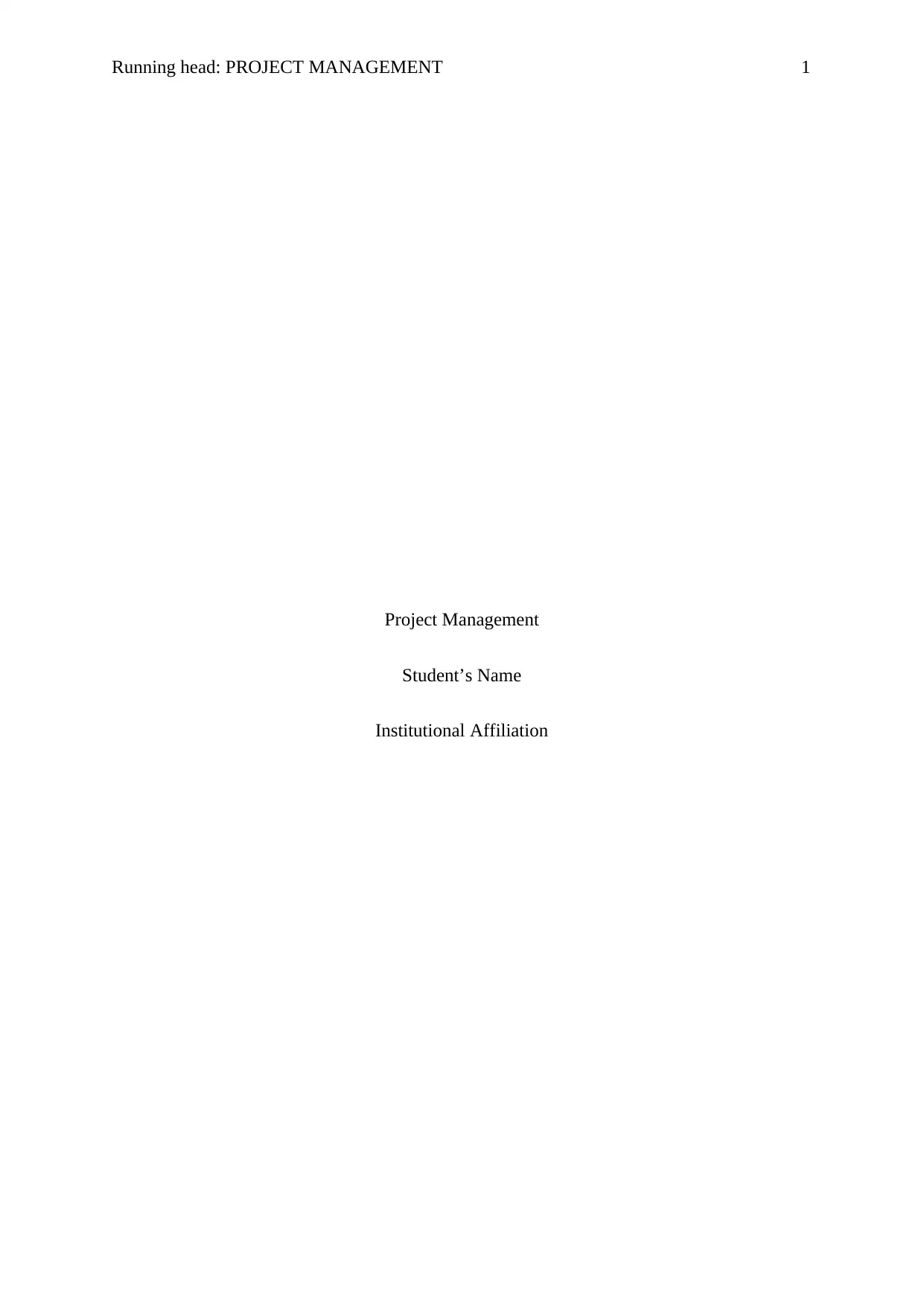
Running head: PROJECT MANAGEMENT 1
Project Management
Student’s Name
Institutional Affiliation
Project Management
Student’s Name
Institutional Affiliation
Secure Best Marks with AI Grader
Need help grading? Try our AI Grader for instant feedback on your assignments.
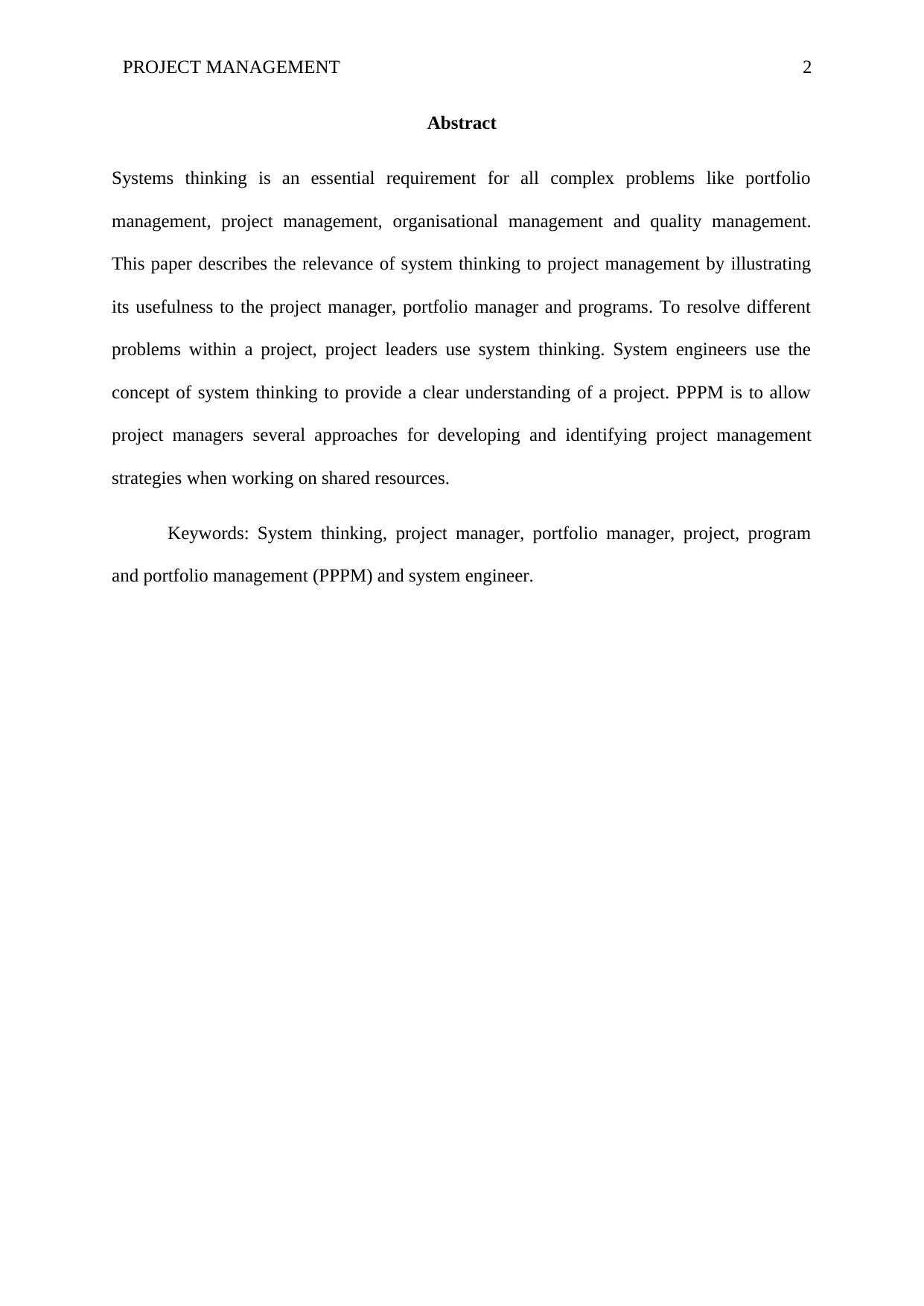
PROJECT MANAGEMENT 2
Abstract
Systems thinking is an essential requirement for all complex problems like portfolio
management, project management, organisational management and quality management.
This paper describes the relevance of system thinking to project management by illustrating
its usefulness to the project manager, portfolio manager and programs. To resolve different
problems within a project, project leaders use system thinking. System engineers use the
concept of system thinking to provide a clear understanding of a project. PPPM is to allow
project managers several approaches for developing and identifying project management
strategies when working on shared resources.
Keywords: System thinking, project manager, portfolio manager, project, program
and portfolio management (PPPM) and system engineer.
Abstract
Systems thinking is an essential requirement for all complex problems like portfolio
management, project management, organisational management and quality management.
This paper describes the relevance of system thinking to project management by illustrating
its usefulness to the project manager, portfolio manager and programs. To resolve different
problems within a project, project leaders use system thinking. System engineers use the
concept of system thinking to provide a clear understanding of a project. PPPM is to allow
project managers several approaches for developing and identifying project management
strategies when working on shared resources.
Keywords: System thinking, project manager, portfolio manager, project, program
and portfolio management (PPPM) and system engineer.
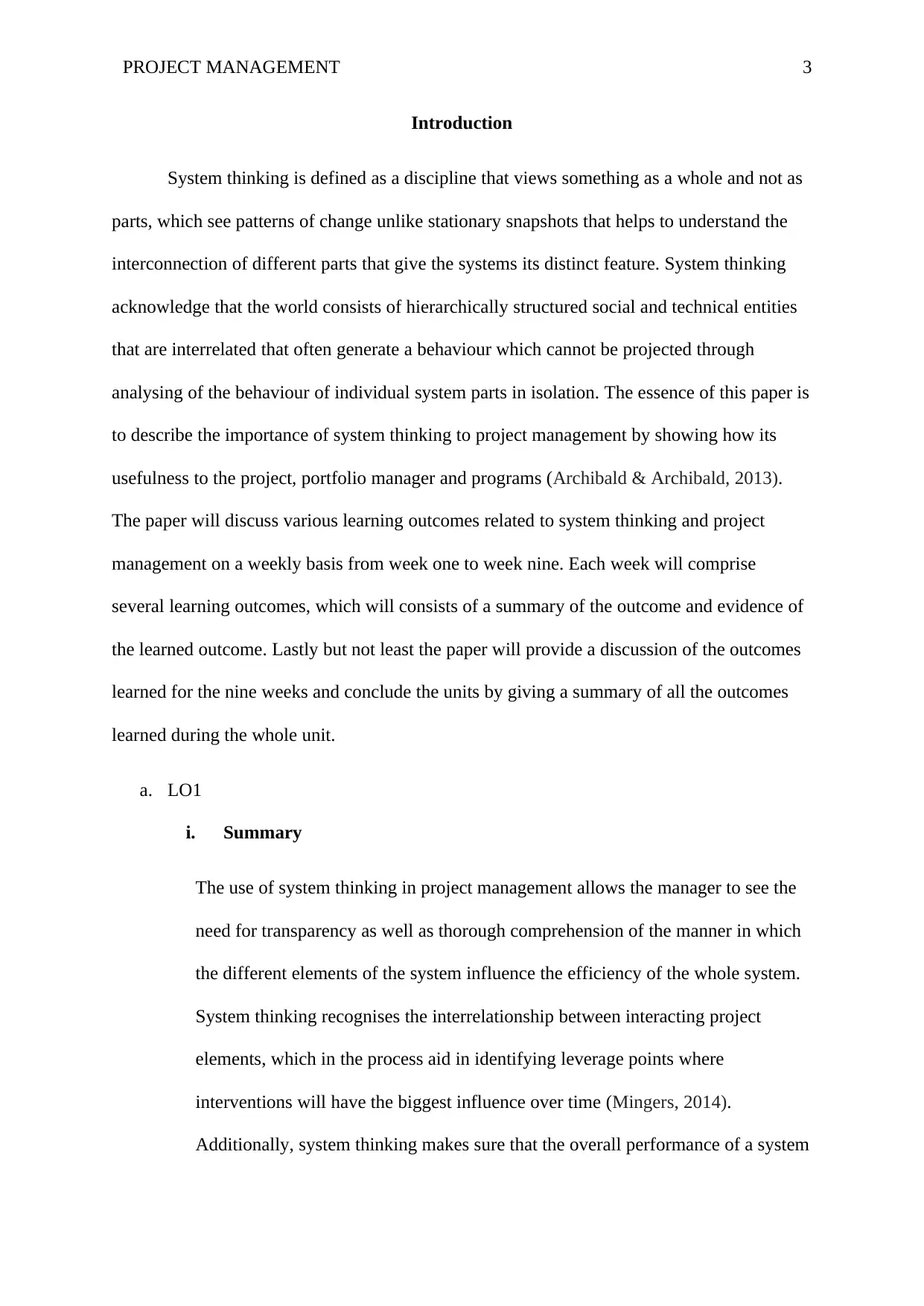
PROJECT MANAGEMENT 3
Introduction
System thinking is defined as a discipline that views something as a whole and not as
parts, which see patterns of change unlike stationary snapshots that helps to understand the
interconnection of different parts that give the systems its distinct feature. System thinking
acknowledge that the world consists of hierarchically structured social and technical entities
that are interrelated that often generate a behaviour which cannot be projected through
analysing of the behaviour of individual system parts in isolation. The essence of this paper is
to describe the importance of system thinking to project management by showing how its
usefulness to the project, portfolio manager and programs (Archibald & Archibald, 2013).
The paper will discuss various learning outcomes related to system thinking and project
management on a weekly basis from week one to week nine. Each week will comprise
several learning outcomes, which will consists of a summary of the outcome and evidence of
the learned outcome. Lastly but not least the paper will provide a discussion of the outcomes
learned for the nine weeks and conclude the units by giving a summary of all the outcomes
learned during the whole unit.
a. LO1
i. Summary
The use of system thinking in project management allows the manager to see the
need for transparency as well as thorough comprehension of the manner in which
the different elements of the system influence the efficiency of the whole system.
System thinking recognises the interrelationship between interacting project
elements, which in the process aid in identifying leverage points where
interventions will have the biggest influence over time (Mingers, 2014).
Additionally, system thinking makes sure that the overall performance of a system
Introduction
System thinking is defined as a discipline that views something as a whole and not as
parts, which see patterns of change unlike stationary snapshots that helps to understand the
interconnection of different parts that give the systems its distinct feature. System thinking
acknowledge that the world consists of hierarchically structured social and technical entities
that are interrelated that often generate a behaviour which cannot be projected through
analysing of the behaviour of individual system parts in isolation. The essence of this paper is
to describe the importance of system thinking to project management by showing how its
usefulness to the project, portfolio manager and programs (Archibald & Archibald, 2013).
The paper will discuss various learning outcomes related to system thinking and project
management on a weekly basis from week one to week nine. Each week will comprise
several learning outcomes, which will consists of a summary of the outcome and evidence of
the learned outcome. Lastly but not least the paper will provide a discussion of the outcomes
learned for the nine weeks and conclude the units by giving a summary of all the outcomes
learned during the whole unit.
a. LO1
i. Summary
The use of system thinking in project management allows the manager to see the
need for transparency as well as thorough comprehension of the manner in which
the different elements of the system influence the efficiency of the whole system.
System thinking recognises the interrelationship between interacting project
elements, which in the process aid in identifying leverage points where
interventions will have the biggest influence over time (Mingers, 2014).
Additionally, system thinking makes sure that the overall performance of a system
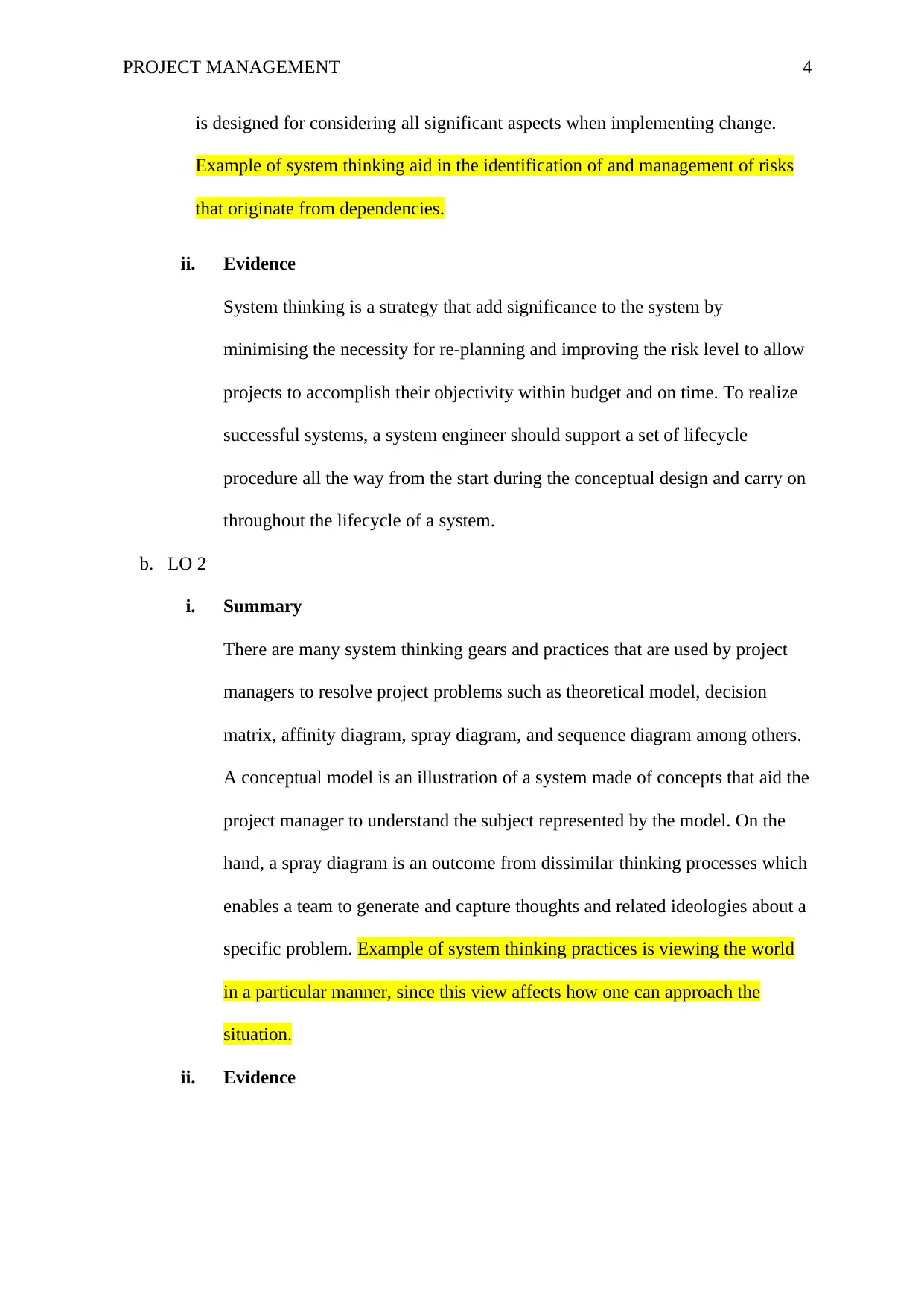
PROJECT MANAGEMENT 4
is designed for considering all significant aspects when implementing change.
Example of system thinking aid in the identification of and management of risks
that originate from dependencies.
ii. Evidence
System thinking is a strategy that add significance to the system by
minimising the necessity for re-planning and improving the risk level to allow
projects to accomplish their objectivity within budget and on time. To realize
successful systems, a system engineer should support a set of lifecycle
procedure all the way from the start during the conceptual design and carry on
throughout the lifecycle of a system.
b. LO 2
i. Summary
There are many system thinking gears and practices that are used by project
managers to resolve project problems such as theoretical model, decision
matrix, affinity diagram, spray diagram, and sequence diagram among others.
A conceptual model is an illustration of a system made of concepts that aid the
project manager to understand the subject represented by the model. On the
hand, a spray diagram is an outcome from dissimilar thinking processes which
enables a team to generate and capture thoughts and related ideologies about a
specific problem. Example of system thinking practices is viewing the world
in a particular manner, since this view affects how one can approach the
situation.
ii. Evidence
is designed for considering all significant aspects when implementing change.
Example of system thinking aid in the identification of and management of risks
that originate from dependencies.
ii. Evidence
System thinking is a strategy that add significance to the system by
minimising the necessity for re-planning and improving the risk level to allow
projects to accomplish their objectivity within budget and on time. To realize
successful systems, a system engineer should support a set of lifecycle
procedure all the way from the start during the conceptual design and carry on
throughout the lifecycle of a system.
b. LO 2
i. Summary
There are many system thinking gears and practices that are used by project
managers to resolve project problems such as theoretical model, decision
matrix, affinity diagram, spray diagram, and sequence diagram among others.
A conceptual model is an illustration of a system made of concepts that aid the
project manager to understand the subject represented by the model. On the
hand, a spray diagram is an outcome from dissimilar thinking processes which
enables a team to generate and capture thoughts and related ideologies about a
specific problem. Example of system thinking practices is viewing the world
in a particular manner, since this view affects how one can approach the
situation.
ii. Evidence
Secure Best Marks with AI Grader
Need help grading? Try our AI Grader for instant feedback on your assignments.
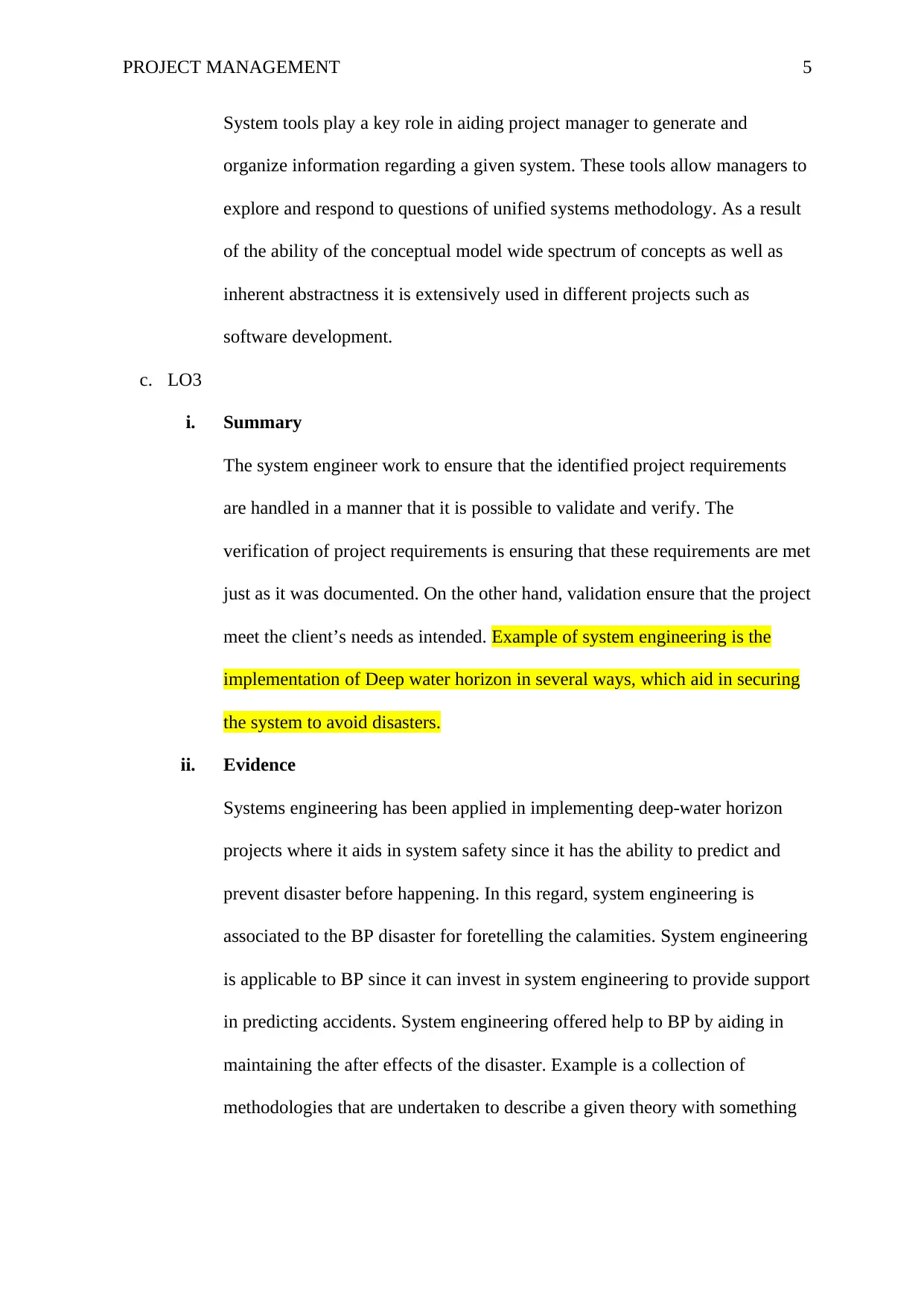
PROJECT MANAGEMENT 5
System tools play a key role in aiding project manager to generate and
organize information regarding a given system. These tools allow managers to
explore and respond to questions of unified systems methodology. As a result
of the ability of the conceptual model wide spectrum of concepts as well as
inherent abstractness it is extensively used in different projects such as
software development.
c. LO3
i. Summary
The system engineer work to ensure that the identified project requirements
are handled in a manner that it is possible to validate and verify. The
verification of project requirements is ensuring that these requirements are met
just as it was documented. On the other hand, validation ensure that the project
meet the client’s needs as intended. Example of system engineering is the
implementation of Deep water horizon in several ways, which aid in securing
the system to avoid disasters.
ii. Evidence
Systems engineering has been applied in implementing deep-water horizon
projects where it aids in system safety since it has the ability to predict and
prevent disaster before happening. In this regard, system engineering is
associated to the BP disaster for foretelling the calamities. System engineering
is applicable to BP since it can invest in system engineering to provide support
in predicting accidents. System engineering offered help to BP by aiding in
maintaining the after effects of the disaster. Example is a collection of
methodologies that are undertaken to describe a given theory with something
System tools play a key role in aiding project manager to generate and
organize information regarding a given system. These tools allow managers to
explore and respond to questions of unified systems methodology. As a result
of the ability of the conceptual model wide spectrum of concepts as well as
inherent abstractness it is extensively used in different projects such as
software development.
c. LO3
i. Summary
The system engineer work to ensure that the identified project requirements
are handled in a manner that it is possible to validate and verify. The
verification of project requirements is ensuring that these requirements are met
just as it was documented. On the other hand, validation ensure that the project
meet the client’s needs as intended. Example of system engineering is the
implementation of Deep water horizon in several ways, which aid in securing
the system to avoid disasters.
ii. Evidence
Systems engineering has been applied in implementing deep-water horizon
projects where it aids in system safety since it has the ability to predict and
prevent disaster before happening. In this regard, system engineering is
associated to the BP disaster for foretelling the calamities. System engineering
is applicable to BP since it can invest in system engineering to provide support
in predicting accidents. System engineering offered help to BP by aiding in
maintaining the after effects of the disaster. Example is a collection of
methodologies that are undertaken to describe a given theory with something
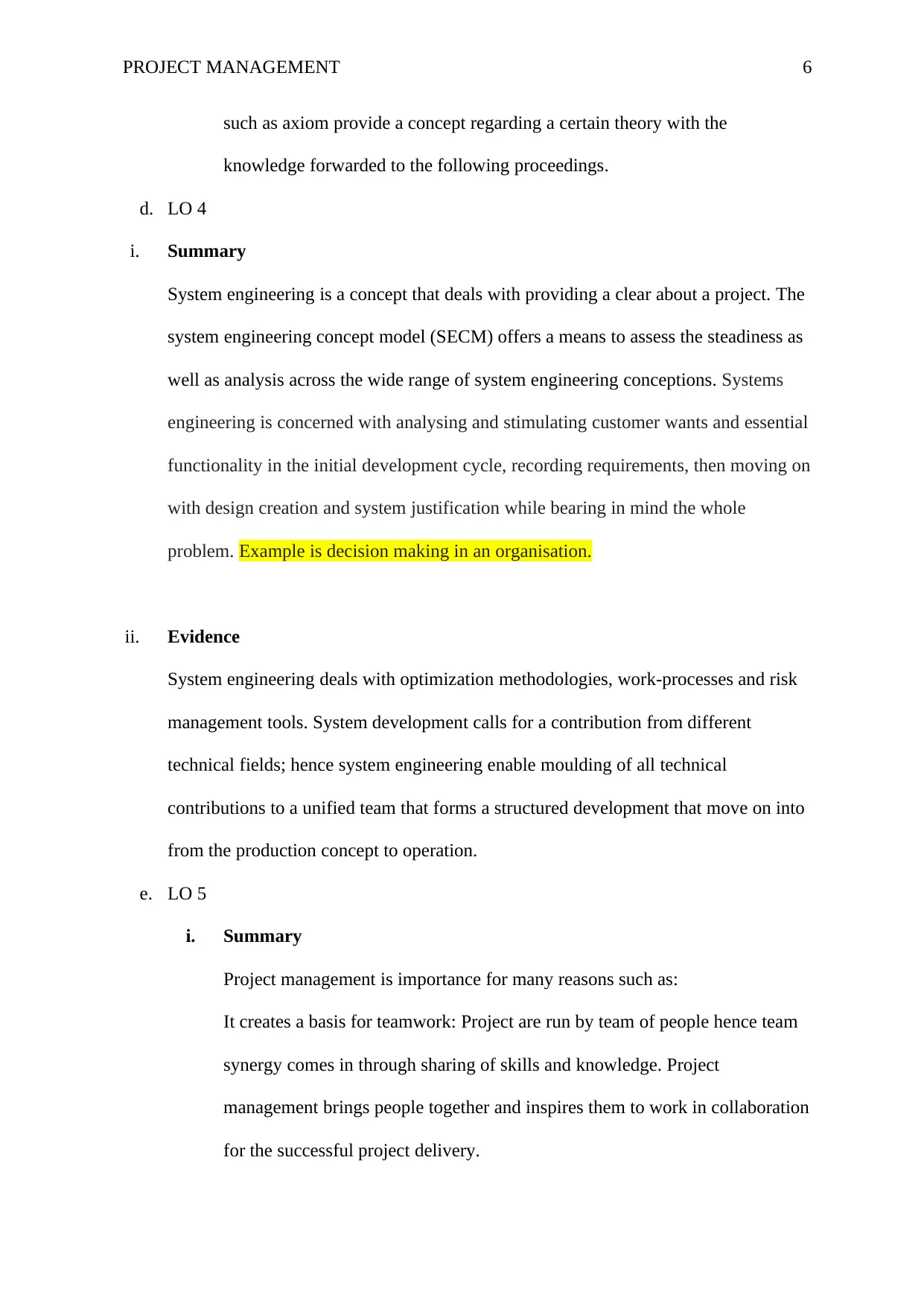
PROJECT MANAGEMENT 6
such as axiom provide a concept regarding a certain theory with the
knowledge forwarded to the following proceedings.
d. LO 4
i. Summary
System engineering is a concept that deals with providing a clear about a project. The
system engineering concept model (SECM) offers a means to assess the steadiness as
well as analysis across the wide range of system engineering conceptions. Systems
engineering is concerned with analysing and stimulating customer wants and essential
functionality in the initial development cycle, recording requirements, then moving on
with design creation and system justification while bearing in mind the whole
problem. Example is decision making in an organisation.
ii. Evidence
System engineering deals with optimization methodologies, work-processes and risk
management tools. System development calls for a contribution from different
technical fields; hence system engineering enable moulding of all technical
contributions to a unified team that forms a structured development that move on into
from the production concept to operation.
e. LO 5
i. Summary
Project management is importance for many reasons such as:
It creates a basis for teamwork: Project are run by team of people hence team
synergy comes in through sharing of skills and knowledge. Project
management brings people together and inspires them to work in collaboration
for the successful project delivery.
such as axiom provide a concept regarding a certain theory with the
knowledge forwarded to the following proceedings.
d. LO 4
i. Summary
System engineering is a concept that deals with providing a clear about a project. The
system engineering concept model (SECM) offers a means to assess the steadiness as
well as analysis across the wide range of system engineering conceptions. Systems
engineering is concerned with analysing and stimulating customer wants and essential
functionality in the initial development cycle, recording requirements, then moving on
with design creation and system justification while bearing in mind the whole
problem. Example is decision making in an organisation.
ii. Evidence
System engineering deals with optimization methodologies, work-processes and risk
management tools. System development calls for a contribution from different
technical fields; hence system engineering enable moulding of all technical
contributions to a unified team that forms a structured development that move on into
from the production concept to operation.
e. LO 5
i. Summary
Project management is importance for many reasons such as:
It creates a basis for teamwork: Project are run by team of people hence team
synergy comes in through sharing of skills and knowledge. Project
management brings people together and inspires them to work in collaboration
for the successful project delivery.
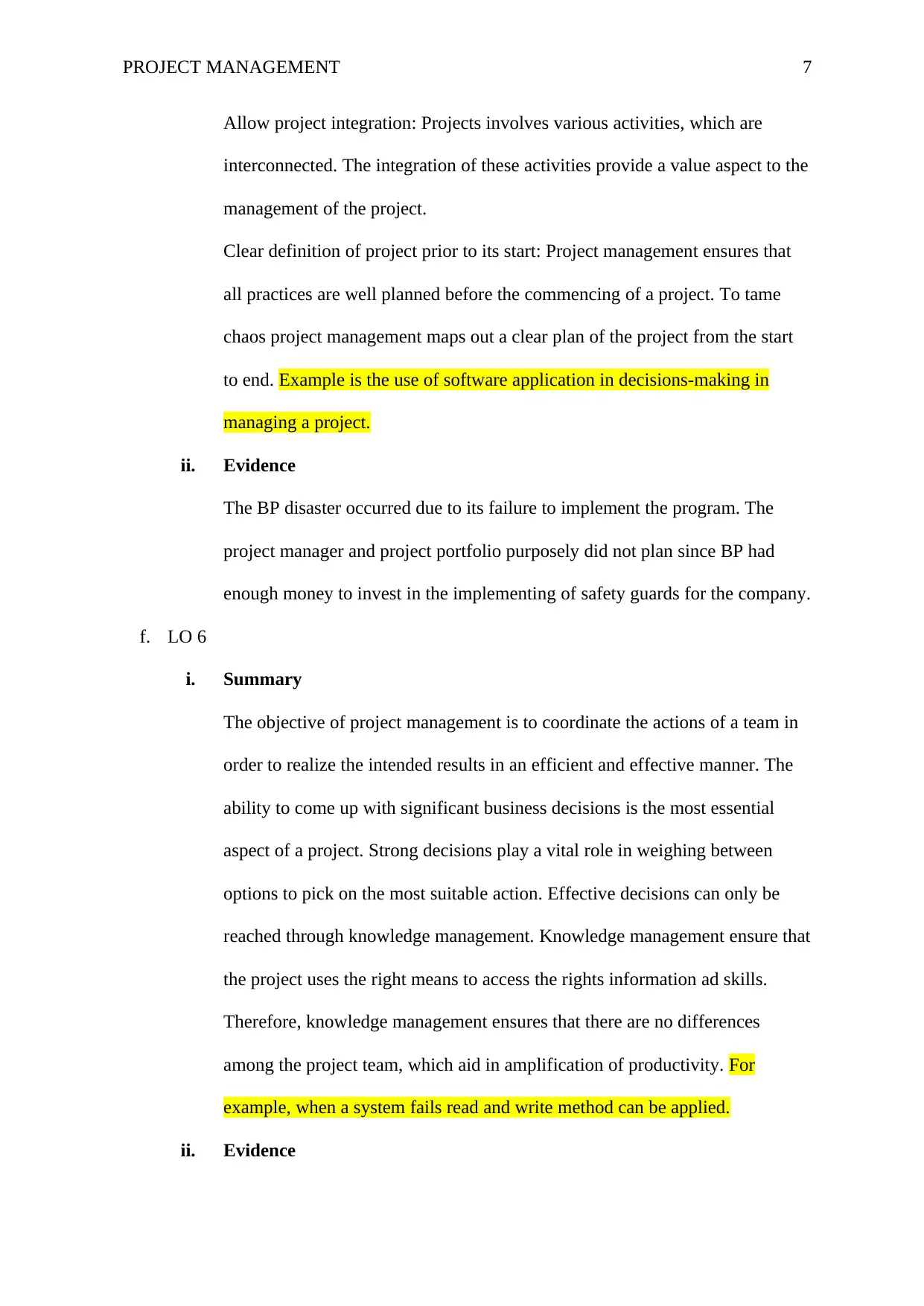
PROJECT MANAGEMENT 7
Allow project integration: Projects involves various activities, which are
interconnected. The integration of these activities provide a value aspect to the
management of the project.
Clear definition of project prior to its start: Project management ensures that
all practices are well planned before the commencing of a project. To tame
chaos project management maps out a clear plan of the project from the start
to end. Example is the use of software application in decisions-making in
managing a project.
ii. Evidence
The BP disaster occurred due to its failure to implement the program. The
project manager and project portfolio purposely did not plan since BP had
enough money to invest in the implementing of safety guards for the company.
f. LO 6
i. Summary
The objective of project management is to coordinate the actions of a team in
order to realize the intended results in an efficient and effective manner. The
ability to come up with significant business decisions is the most essential
aspect of a project. Strong decisions play a vital role in weighing between
options to pick on the most suitable action. Effective decisions can only be
reached through knowledge management. Knowledge management ensure that
the project uses the right means to access the rights information ad skills.
Therefore, knowledge management ensures that there are no differences
among the project team, which aid in amplification of productivity. For
example, when a system fails read and write method can be applied.
ii. Evidence
Allow project integration: Projects involves various activities, which are
interconnected. The integration of these activities provide a value aspect to the
management of the project.
Clear definition of project prior to its start: Project management ensures that
all practices are well planned before the commencing of a project. To tame
chaos project management maps out a clear plan of the project from the start
to end. Example is the use of software application in decisions-making in
managing a project.
ii. Evidence
The BP disaster occurred due to its failure to implement the program. The
project manager and project portfolio purposely did not plan since BP had
enough money to invest in the implementing of safety guards for the company.
f. LO 6
i. Summary
The objective of project management is to coordinate the actions of a team in
order to realize the intended results in an efficient and effective manner. The
ability to come up with significant business decisions is the most essential
aspect of a project. Strong decisions play a vital role in weighing between
options to pick on the most suitable action. Effective decisions can only be
reached through knowledge management. Knowledge management ensure that
the project uses the right means to access the rights information ad skills.
Therefore, knowledge management ensures that there are no differences
among the project team, which aid in amplification of productivity. For
example, when a system fails read and write method can be applied.
ii. Evidence
Paraphrase This Document
Need a fresh take? Get an instant paraphrase of this document with our AI Paraphraser
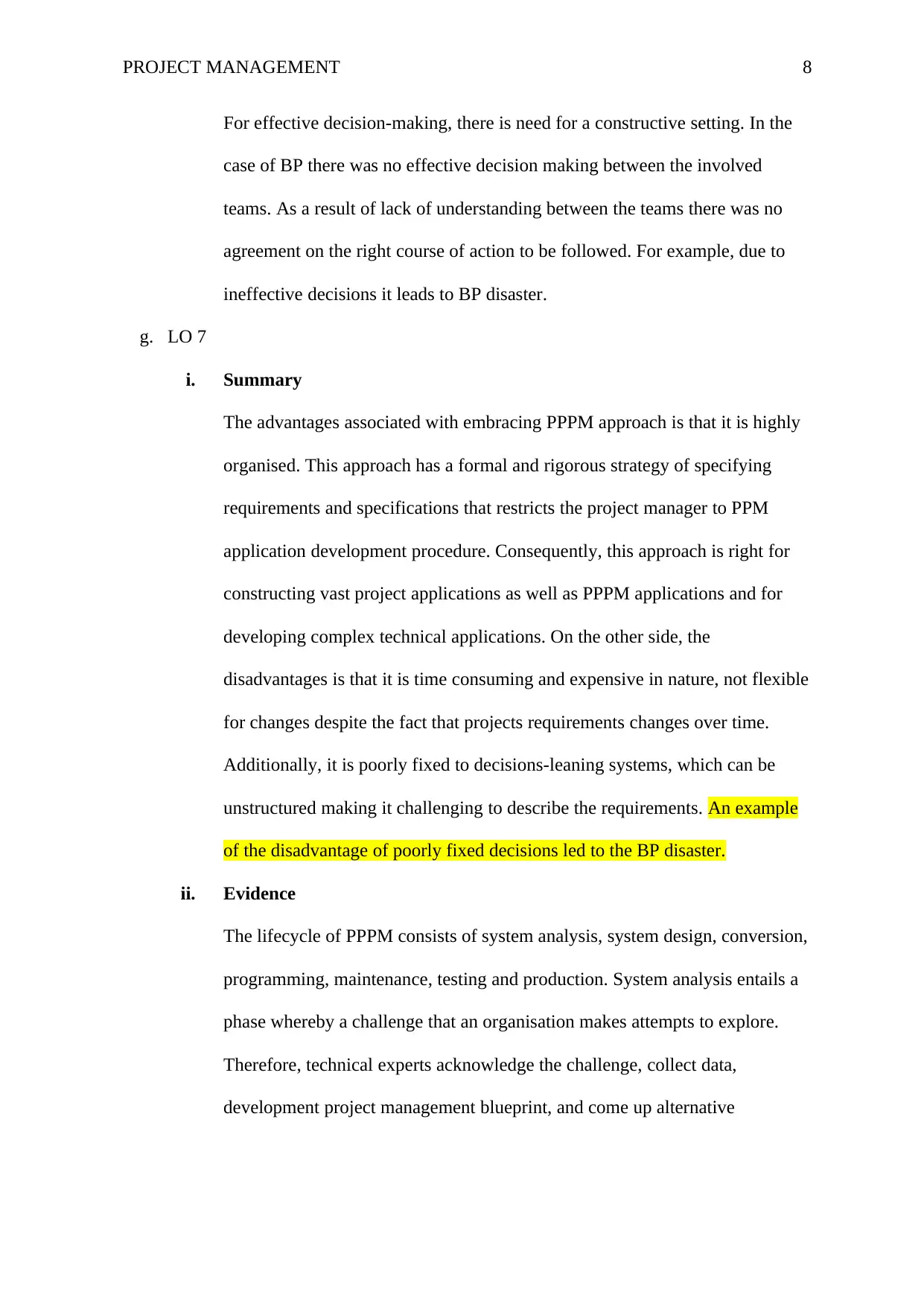
PROJECT MANAGEMENT 8
For effective decision-making, there is need for a constructive setting. In the
case of BP there was no effective decision making between the involved
teams. As a result of lack of understanding between the teams there was no
agreement on the right course of action to be followed. For example, due to
ineffective decisions it leads to BP disaster.
g. LO 7
i. Summary
The advantages associated with embracing PPPM approach is that it is highly
organised. This approach has a formal and rigorous strategy of specifying
requirements and specifications that restricts the project manager to PPM
application development procedure. Consequently, this approach is right for
constructing vast project applications as well as PPPM applications and for
developing complex technical applications. On the other side, the
disadvantages is that it is time consuming and expensive in nature, not flexible
for changes despite the fact that projects requirements changes over time.
Additionally, it is poorly fixed to decisions-leaning systems, which can be
unstructured making it challenging to describe the requirements. An example
of the disadvantage of poorly fixed decisions led to the BP disaster.
ii. Evidence
The lifecycle of PPPM consists of system analysis, system design, conversion,
programming, maintenance, testing and production. System analysis entails a
phase whereby a challenge that an organisation makes attempts to explore.
Therefore, technical experts acknowledge the challenge, collect data,
development project management blueprint, and come up alternative
For effective decision-making, there is need for a constructive setting. In the
case of BP there was no effective decision making between the involved
teams. As a result of lack of understanding between the teams there was no
agreement on the right course of action to be followed. For example, due to
ineffective decisions it leads to BP disaster.
g. LO 7
i. Summary
The advantages associated with embracing PPPM approach is that it is highly
organised. This approach has a formal and rigorous strategy of specifying
requirements and specifications that restricts the project manager to PPM
application development procedure. Consequently, this approach is right for
constructing vast project applications as well as PPPM applications and for
developing complex technical applications. On the other side, the
disadvantages is that it is time consuming and expensive in nature, not flexible
for changes despite the fact that projects requirements changes over time.
Additionally, it is poorly fixed to decisions-leaning systems, which can be
unstructured making it challenging to describe the requirements. An example
of the disadvantage of poorly fixed decisions led to the BP disaster.
ii. Evidence
The lifecycle of PPPM consists of system analysis, system design, conversion,
programming, maintenance, testing and production. System analysis entails a
phase whereby a challenge that an organisation makes attempts to explore.
Therefore, technical experts acknowledge the challenge, collect data,
development project management blueprint, and come up alternative
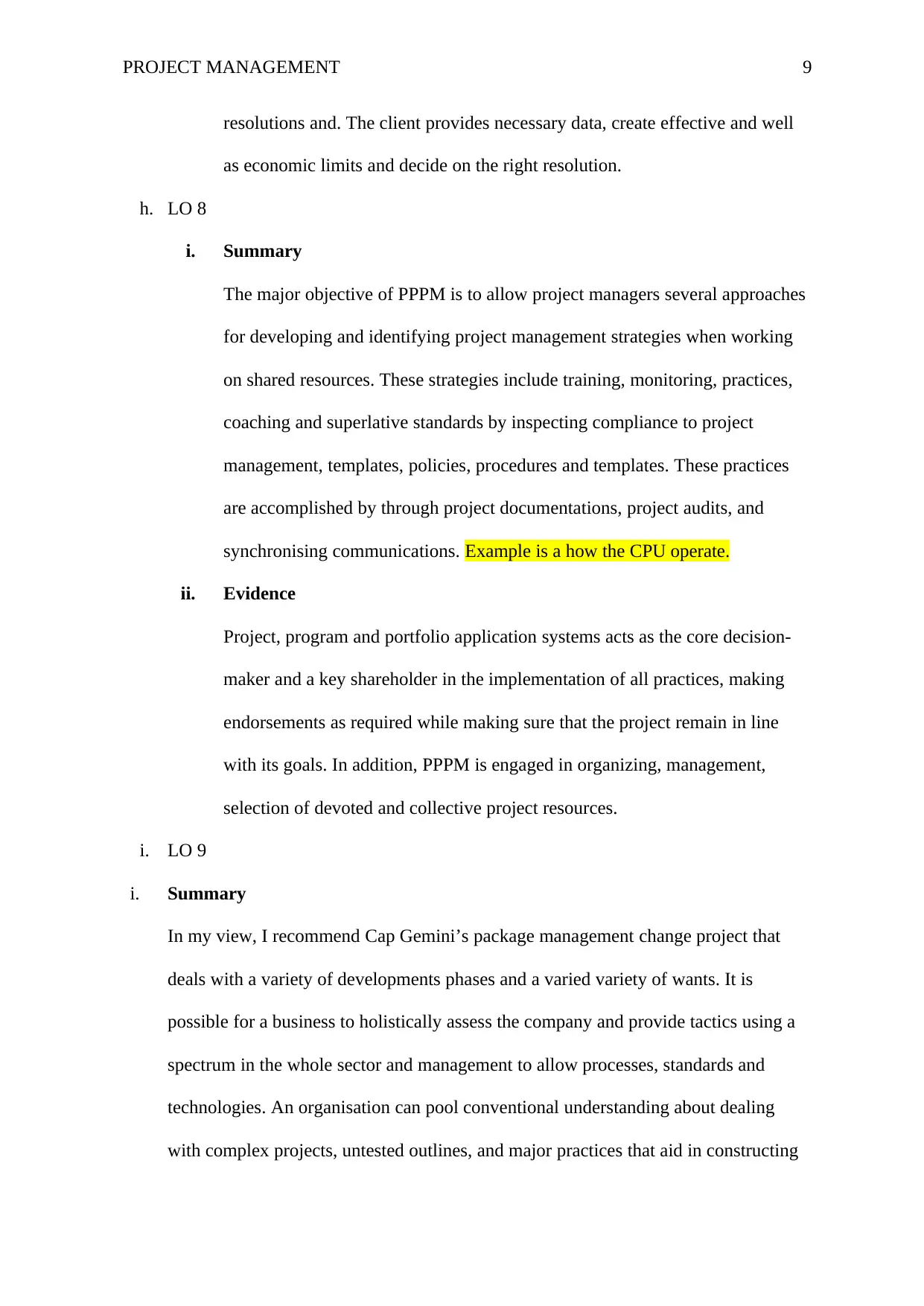
PROJECT MANAGEMENT 9
resolutions and. The client provides necessary data, create effective and well
as economic limits and decide on the right resolution.
h. LO 8
i. Summary
The major objective of PPPM is to allow project managers several approaches
for developing and identifying project management strategies when working
on shared resources. These strategies include training, monitoring, practices,
coaching and superlative standards by inspecting compliance to project
management, templates, policies, procedures and templates. These practices
are accomplished by through project documentations, project audits, and
synchronising communications. Example is a how the CPU operate.
ii. Evidence
Project, program and portfolio application systems acts as the core decision-
maker and a key shareholder in the implementation of all practices, making
endorsements as required while making sure that the project remain in line
with its goals. In addition, PPPM is engaged in organizing, management,
selection of devoted and collective project resources.
i. LO 9
i. Summary
In my view, I recommend Cap Gemini’s package management change project that
deals with a variety of developments phases and a varied variety of wants. It is
possible for a business to holistically assess the company and provide tactics using a
spectrum in the whole sector and management to allow processes, standards and
technologies. An organisation can pool conventional understanding about dealing
with complex projects, untested outlines, and major practices that aid in constructing
resolutions and. The client provides necessary data, create effective and well
as economic limits and decide on the right resolution.
h. LO 8
i. Summary
The major objective of PPPM is to allow project managers several approaches
for developing and identifying project management strategies when working
on shared resources. These strategies include training, monitoring, practices,
coaching and superlative standards by inspecting compliance to project
management, templates, policies, procedures and templates. These practices
are accomplished by through project documentations, project audits, and
synchronising communications. Example is a how the CPU operate.
ii. Evidence
Project, program and portfolio application systems acts as the core decision-
maker and a key shareholder in the implementation of all practices, making
endorsements as required while making sure that the project remain in line
with its goals. In addition, PPPM is engaged in organizing, management,
selection of devoted and collective project resources.
i. LO 9
i. Summary
In my view, I recommend Cap Gemini’s package management change project that
deals with a variety of developments phases and a varied variety of wants. It is
possible for a business to holistically assess the company and provide tactics using a
spectrum in the whole sector and management to allow processes, standards and
technologies. An organisation can pool conventional understanding about dealing
with complex projects, untested outlines, and major practices that aid in constructing
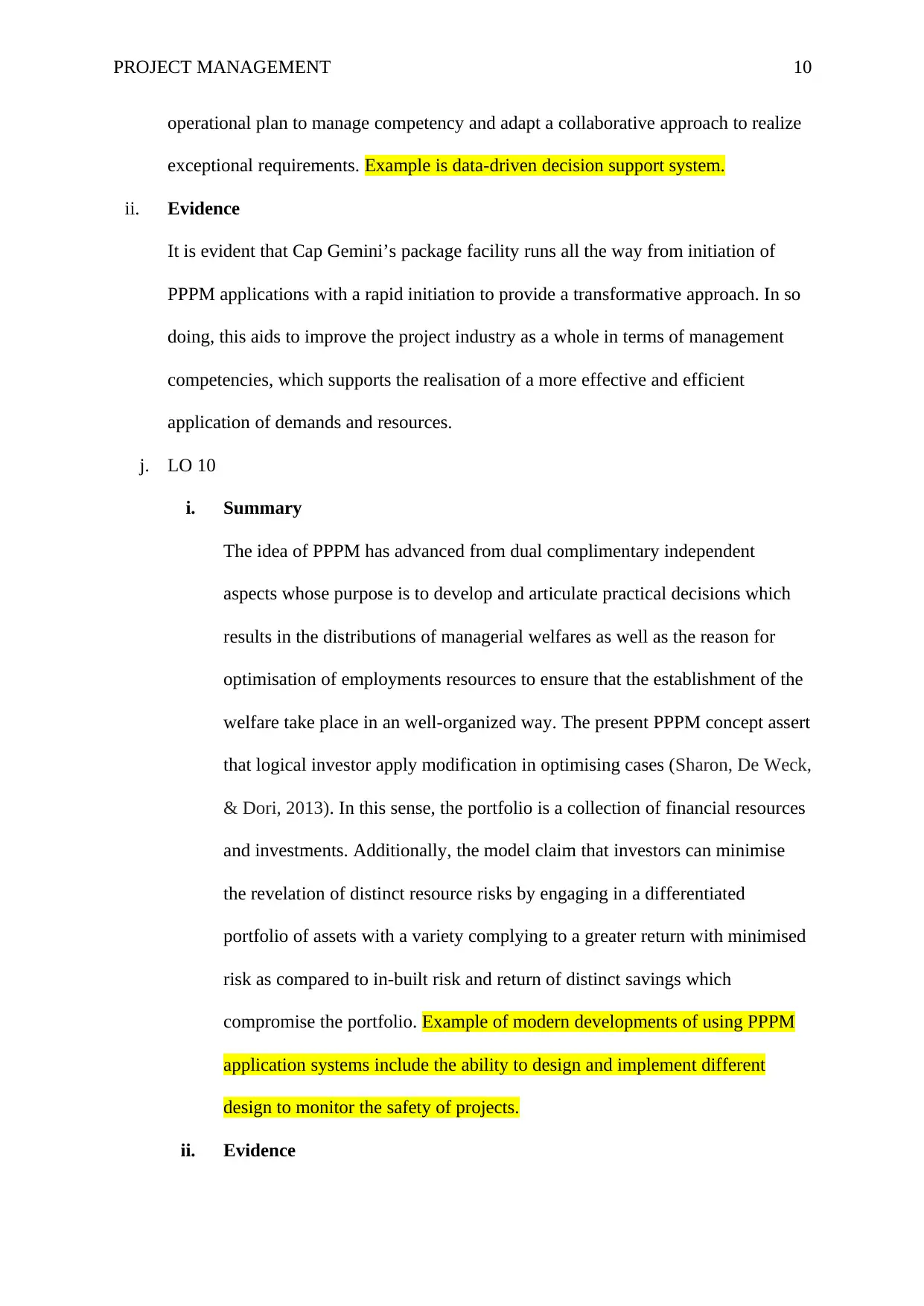
PROJECT MANAGEMENT 10
operational plan to manage competency and adapt a collaborative approach to realize
exceptional requirements. Example is data-driven decision support system.
ii. Evidence
It is evident that Cap Gemini’s package facility runs all the way from initiation of
PPPM applications with a rapid initiation to provide a transformative approach. In so
doing, this aids to improve the project industry as a whole in terms of management
competencies, which supports the realisation of a more effective and efficient
application of demands and resources.
j. LO 10
i. Summary
The idea of PPPM has advanced from dual complimentary independent
aspects whose purpose is to develop and articulate practical decisions which
results in the distributions of managerial welfares as well as the reason for
optimisation of employments resources to ensure that the establishment of the
welfare take place in an well-organized way. The present PPPM concept assert
that logical investor apply modification in optimising cases (Sharon, De Weck,
& Dori, 2013). In this sense, the portfolio is a collection of financial resources
and investments. Additionally, the model claim that investors can minimise
the revelation of distinct resource risks by engaging in a differentiated
portfolio of assets with a variety complying to a greater return with minimised
risk as compared to in-built risk and return of distinct savings which
compromise the portfolio. Example of modern developments of using PPPM
application systems include the ability to design and implement different
design to monitor the safety of projects.
ii. Evidence
operational plan to manage competency and adapt a collaborative approach to realize
exceptional requirements. Example is data-driven decision support system.
ii. Evidence
It is evident that Cap Gemini’s package facility runs all the way from initiation of
PPPM applications with a rapid initiation to provide a transformative approach. In so
doing, this aids to improve the project industry as a whole in terms of management
competencies, which supports the realisation of a more effective and efficient
application of demands and resources.
j. LO 10
i. Summary
The idea of PPPM has advanced from dual complimentary independent
aspects whose purpose is to develop and articulate practical decisions which
results in the distributions of managerial welfares as well as the reason for
optimisation of employments resources to ensure that the establishment of the
welfare take place in an well-organized way. The present PPPM concept assert
that logical investor apply modification in optimising cases (Sharon, De Weck,
& Dori, 2013). In this sense, the portfolio is a collection of financial resources
and investments. Additionally, the model claim that investors can minimise
the revelation of distinct resource risks by engaging in a differentiated
portfolio of assets with a variety complying to a greater return with minimised
risk as compared to in-built risk and return of distinct savings which
compromise the portfolio. Example of modern developments of using PPPM
application systems include the ability to design and implement different
design to monitor the safety of projects.
ii. Evidence
Secure Best Marks with AI Grader
Need help grading? Try our AI Grader for instant feedback on your assignments.
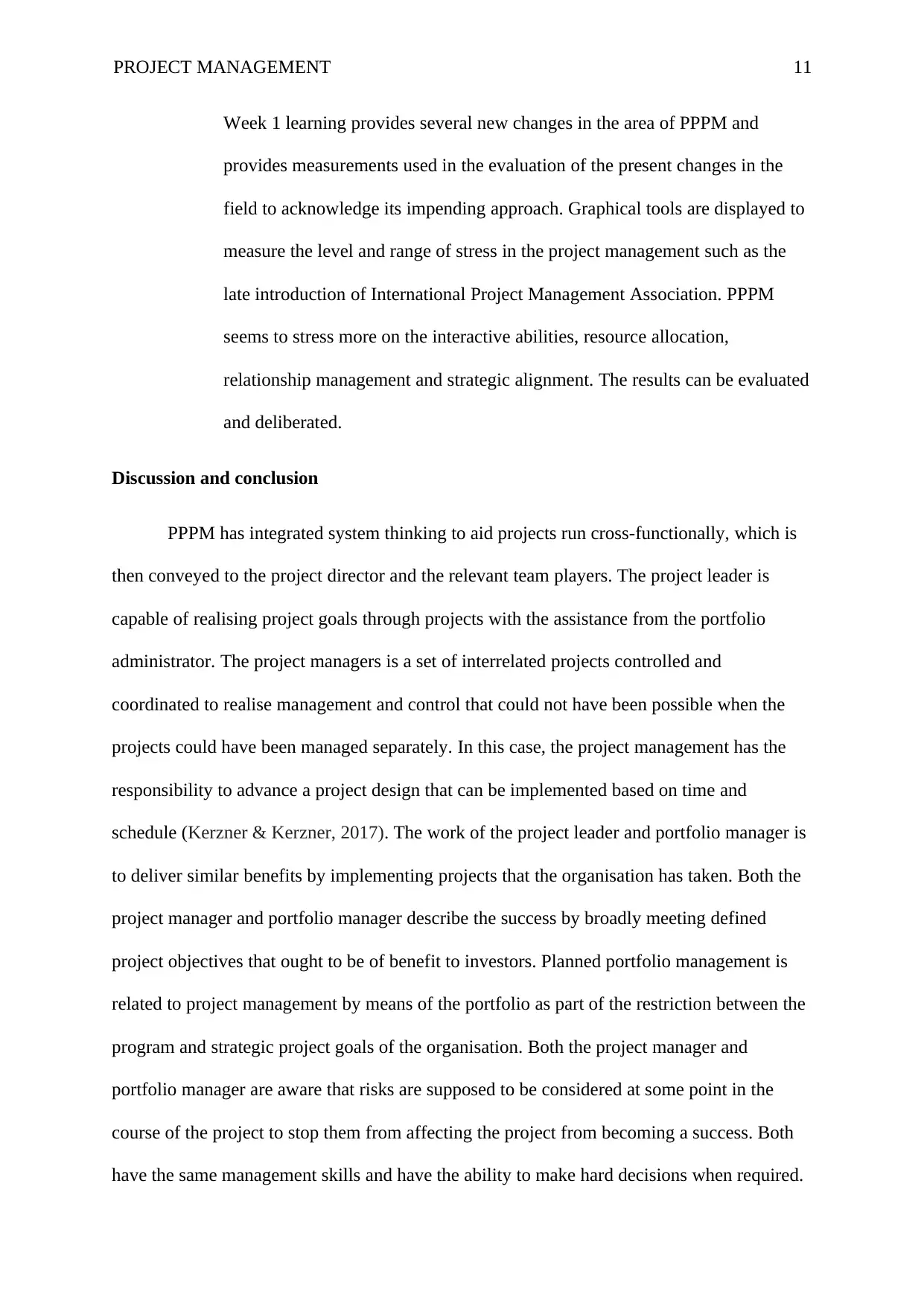
PROJECT MANAGEMENT 11
Week 1 learning provides several new changes in the area of PPPM and
provides measurements used in the evaluation of the present changes in the
field to acknowledge its impending approach. Graphical tools are displayed to
measure the level and range of stress in the project management such as the
late introduction of International Project Management Association. PPPM
seems to stress more on the interactive abilities, resource allocation,
relationship management and strategic alignment. The results can be evaluated
and deliberated.
Discussion and conclusion
PPPM has integrated system thinking to aid projects run cross-functionally, which is
then conveyed to the project director and the relevant team players. The project leader is
capable of realising project goals through projects with the assistance from the portfolio
administrator. The project managers is a set of interrelated projects controlled and
coordinated to realise management and control that could not have been possible when the
projects could have been managed separately. In this case, the project management has the
responsibility to advance a project design that can be implemented based on time and
schedule (Kerzner & Kerzner, 2017). The work of the project leader and portfolio manager is
to deliver similar benefits by implementing projects that the organisation has taken. Both the
project manager and portfolio manager describe the success by broadly meeting defined
project objectives that ought to be of benefit to investors. Planned portfolio management is
related to project management by means of the portfolio as part of the restriction between the
program and strategic project goals of the organisation. Both the project manager and
portfolio manager are aware that risks are supposed to be considered at some point in the
course of the project to stop them from affecting the project from becoming a success. Both
have the same management skills and have the ability to make hard decisions when required.
Week 1 learning provides several new changes in the area of PPPM and
provides measurements used in the evaluation of the present changes in the
field to acknowledge its impending approach. Graphical tools are displayed to
measure the level and range of stress in the project management such as the
late introduction of International Project Management Association. PPPM
seems to stress more on the interactive abilities, resource allocation,
relationship management and strategic alignment. The results can be evaluated
and deliberated.
Discussion and conclusion
PPPM has integrated system thinking to aid projects run cross-functionally, which is
then conveyed to the project director and the relevant team players. The project leader is
capable of realising project goals through projects with the assistance from the portfolio
administrator. The project managers is a set of interrelated projects controlled and
coordinated to realise management and control that could not have been possible when the
projects could have been managed separately. In this case, the project management has the
responsibility to advance a project design that can be implemented based on time and
schedule (Kerzner & Kerzner, 2017). The work of the project leader and portfolio manager is
to deliver similar benefits by implementing projects that the organisation has taken. Both the
project manager and portfolio manager describe the success by broadly meeting defined
project objectives that ought to be of benefit to investors. Planned portfolio management is
related to project management by means of the portfolio as part of the restriction between the
program and strategic project goals of the organisation. Both the project manager and
portfolio manager are aware that risks are supposed to be considered at some point in the
course of the project to stop them from affecting the project from becoming a success. Both
have the same management skills and have the ability to make hard decisions when required.
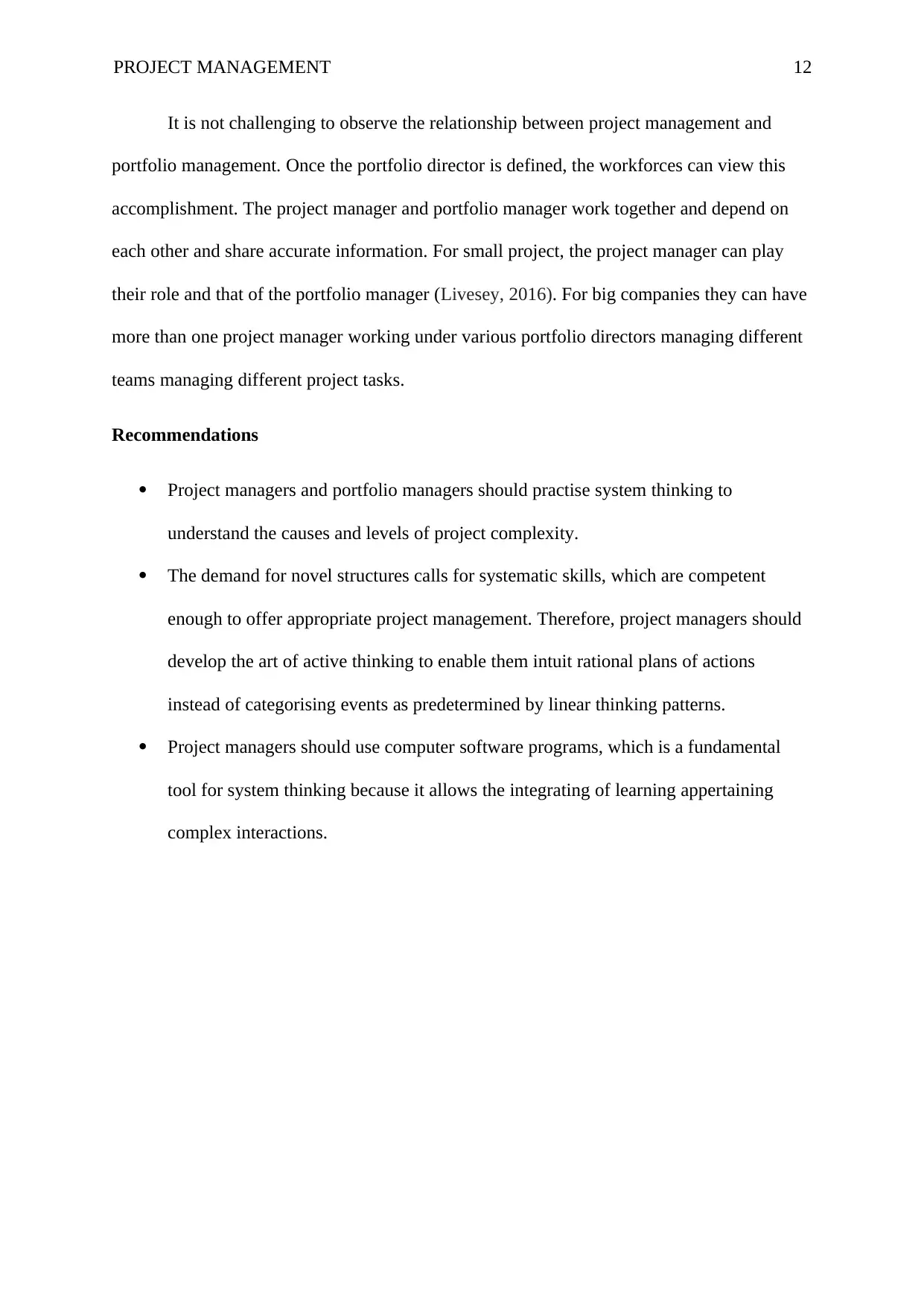
PROJECT MANAGEMENT 12
It is not challenging to observe the relationship between project management and
portfolio management. Once the portfolio director is defined, the workforces can view this
accomplishment. The project manager and portfolio manager work together and depend on
each other and share accurate information. For small project, the project manager can play
their role and that of the portfolio manager (Livesey, 2016). For big companies they can have
more than one project manager working under various portfolio directors managing different
teams managing different project tasks.
Recommendations
Project managers and portfolio managers should practise system thinking to
understand the causes and levels of project complexity.
The demand for novel structures calls for systematic skills, which are competent
enough to offer appropriate project management. Therefore, project managers should
develop the art of active thinking to enable them intuit rational plans of actions
instead of categorising events as predetermined by linear thinking patterns.
Project managers should use computer software programs, which is a fundamental
tool for system thinking because it allows the integrating of learning appertaining
complex interactions.
It is not challenging to observe the relationship between project management and
portfolio management. Once the portfolio director is defined, the workforces can view this
accomplishment. The project manager and portfolio manager work together and depend on
each other and share accurate information. For small project, the project manager can play
their role and that of the portfolio manager (Livesey, 2016). For big companies they can have
more than one project manager working under various portfolio directors managing different
teams managing different project tasks.
Recommendations
Project managers and portfolio managers should practise system thinking to
understand the causes and levels of project complexity.
The demand for novel structures calls for systematic skills, which are competent
enough to offer appropriate project management. Therefore, project managers should
develop the art of active thinking to enable them intuit rational plans of actions
instead of categorising events as predetermined by linear thinking patterns.
Project managers should use computer software programs, which is a fundamental
tool for system thinking because it allows the integrating of learning appertaining
complex interactions.

PROJECT MANAGEMENT 13
Paraphrase This Document
Need a fresh take? Get an instant paraphrase of this document with our AI Paraphraser
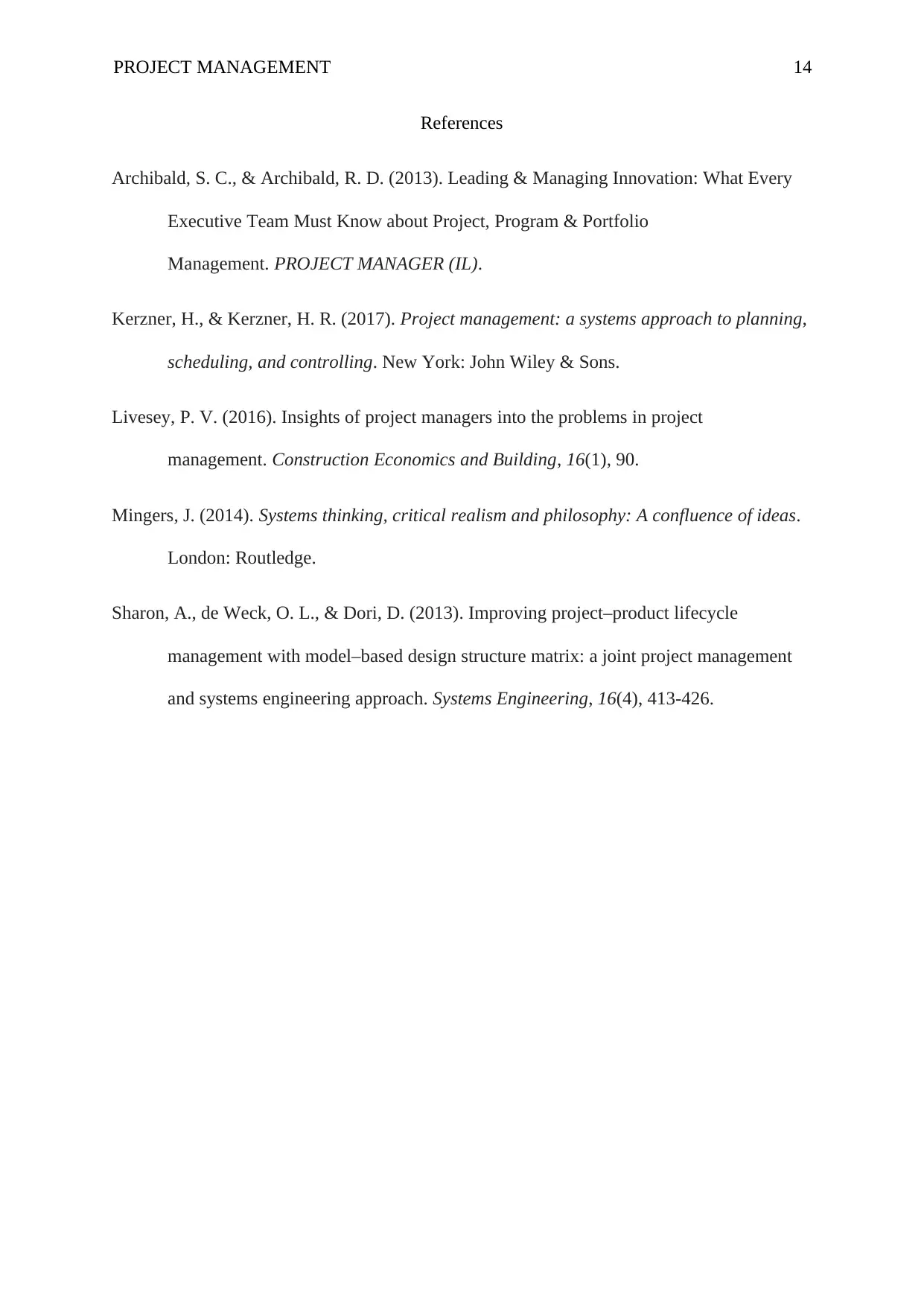
PROJECT MANAGEMENT 14
References
Archibald, S. C., & Archibald, R. D. (2013). Leading & Managing Innovation: What Every
Executive Team Must Know about Project, Program & Portfolio
Management. PROJECT MANAGER (IL).
Kerzner, H., & Kerzner, H. R. (2017). Project management: a systems approach to planning,
scheduling, and controlling. New York: John Wiley & Sons.
Livesey, P. V. (2016). Insights of project managers into the problems in project
management. Construction Economics and Building, 16(1), 90.
Mingers, J. (2014). Systems thinking, critical realism and philosophy: A confluence of ideas.
London: Routledge.
Sharon, A., de Weck, O. L., & Dori, D. (2013). Improving project–product lifecycle
management with model–based design structure matrix: a joint project management
and systems engineering approach. Systems Engineering, 16(4), 413-426.
References
Archibald, S. C., & Archibald, R. D. (2013). Leading & Managing Innovation: What Every
Executive Team Must Know about Project, Program & Portfolio
Management. PROJECT MANAGER (IL).
Kerzner, H., & Kerzner, H. R. (2017). Project management: a systems approach to planning,
scheduling, and controlling. New York: John Wiley & Sons.
Livesey, P. V. (2016). Insights of project managers into the problems in project
management. Construction Economics and Building, 16(1), 90.
Mingers, J. (2014). Systems thinking, critical realism and philosophy: A confluence of ideas.
London: Routledge.
Sharon, A., de Weck, O. L., & Dori, D. (2013). Improving project–product lifecycle
management with model–based design structure matrix: a joint project management
and systems engineering approach. Systems Engineering, 16(4), 413-426.
1 out of 14
Related Documents
Your All-in-One AI-Powered Toolkit for Academic Success.
+13062052269
info@desklib.com
Available 24*7 on WhatsApp / Email
![[object Object]](/_next/static/media/star-bottom.7253800d.svg)
Unlock your academic potential
© 2024 | Zucol Services PVT LTD | All rights reserved.





